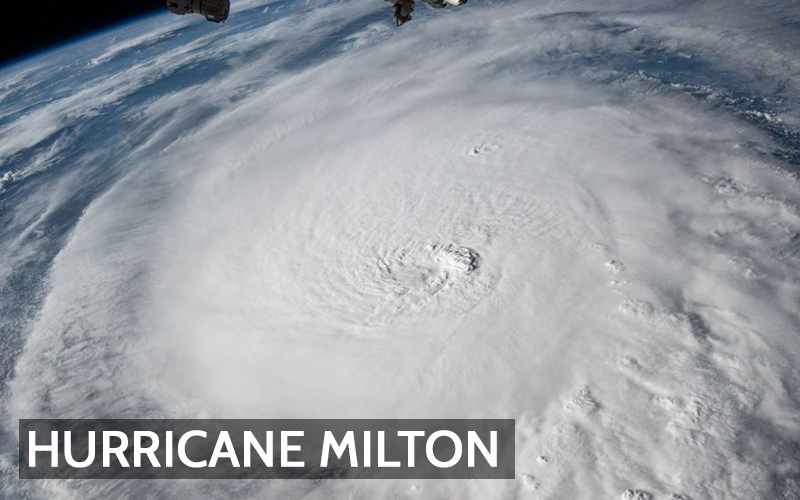Coastal storms produce numerous hazards from wind damage to catastrophic flooding, yet, their impact on air quality often goes overlooked. Recently, Hurricane Milton—a Category 5 hurricane at its peak—devastated Florida’s Gulf Coast, temporarily reshaping air quality across the coast.
The Immediate Effects on Outdoor Air Quality
When a hurricane like Milton makes landfall, it introduces pollutants into the atmosphere through unexpected mechanisms. As high winds stir up particles from soil and vegetation, outdoor air can become laden with particulate matter (PM), a complex mix of tiny particles, chemicals, and organic materials harmful to human health. During intense storms, the combination of PM and airborne salts from seawater spray exacerbates poor air quality, particularly along coastal regions.
Moreover, hurricanes disrupt local ecosystems, including salt marshes and coastal wetlands, releasing previously trapped pollutants. Floodwaters pick up contaminants from both natural and man-made sources—decomposing organic materials, industrial runoff, and even sewage—and as the waters recede, pollutants are carried back into the atmosphere, raising air pollution levels and creating a lingering risk for respiratory and cardiovascular issues.
Indoor Air Quality Challenges After Storms
While storms affect outdoor air, the impacts extend indoors as well, especially during power outages. As people close windows and shelter indoors, contaminants from flooded areas often infiltrate homes, exposing residents to mold, volatile organic compounds (VOCs), and other pollutants. In the case of Hurricane Milton, extensive flooding in residential and commercial areas posed long-term challenges to indoor air quality. Damp interiors and limited ventilation create ideal conditions for mold growth, which can continue to impact air quality and health for weeks or even months after the initial storm.
Indoor air quality also suffers from compromised HVAC systems. With power outages common after major hurricanes, many air conditioning units and filters become inoperative, making it difficult to control humidity levels or filter out pollutants that accumulate in closed spaces. This adds to the respiratory risks for people already facing poor air quality in storm-affected areas.
The Role of Sea Level Rise and Coastal Flooding
As sea levels rise, coastal storms become more impactful, leading to higher flood risks and further deterioration of air quality. Sea level rise increases the reach of storm surges, allowing flooding in more populated inland areas, and as these floodwaters stagnate, pollutants enter the air. Increased salinity and particulate matter from these surges can elevate local air pollution for days following the storm.
Higher sea levels also mean that coastal zones see an accumulation of salt particles, adding to the stress on local air quality. Salt particles can corrode buildings and infrastructure, leading to a greater release of pollutants into the air as damaged materials break down. For areas near the coast, this only amplifies the immediate impacts that storms like Hurricane Milton have on air quality.
Health Impacts of Poor Air Quality After Hurricanes
Polluted air, exacerbated by hurricane conditions, poses serious health risks, especially for individuals with pre-existing respiratory or cardiovascular conditions. As seen with Hurricane Milton, toxic exposure becomes a concern as storm-borne pollutants reach hazardous levels. Particulate matter especially is small enough to bypass the body’s natural defenses and reach deep into the lungs, triggering inflammation, worsening asthma, and potentially leading to severe health outcomes.
The health risks are even greater for vulnerable populations, including children, the elderly, and those with compromised immune systems. In these groups, exposure to poor air quality following hurricanes can lead to increased hospitalizations and long-term health complications.
Adaptation and Preparedness for the Future
To better protect coastal communities, adaptation efforts are critical. This includes building flood-resilient infrastructure and incorporating nature-based solutions, such as restoring coastal ecosystems that can act as natural buffers against flooding. Additionally, communities should invest in improving indoor air quality management, particularly in homes and shelters, by ensuring accessible air filtration systems and resources for post-storm cleanup.
With hurricanes expected to increase in intensity due to climate change, proactive measures in both urban planning and community education are essential. From deploying portable air filters to maintaining humidity control systems, there are numerous ways to mitigate the air quality impacts that follow in the wake of a hurricane.
Hurricane Milton highlighted the intricate and far-reaching impact of the way hurricanes affect air quality, emphasizing the need for public awareness and proactive responses to safeguard health. As climate conditions evolve, understanding and addressing these air quality issues will be essential for protecting coastal populations and minimizing health risks.


